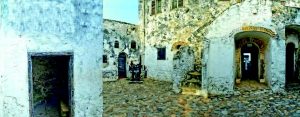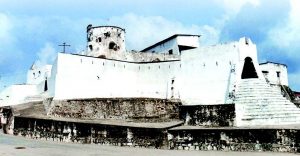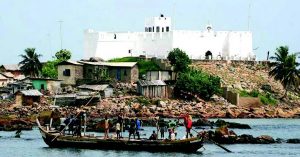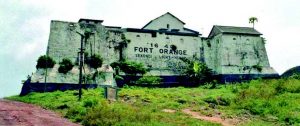Fort St. Anthony
A trip to Ghana is never a wasted effort because there is a lot to learn beyond experiencing the diverse cultures out here.
The tourism value out here is, indeed, enormous to suit everyone’s taste.
Last week, NEWS-ONE highlighted the fact that Ghana is a world historic hub for colonial forts and castles which are found on the country’s coastline.
There are a lot of them out here. They have not only been described as significant and emotive symbol of European-African encounters but also the starting point of the African diaspora.
Most of the forts were erected between 1482 and 1786, and they can still be seen along the coast of Ghana between Keta and Beyin.
This paper listed a number of them last week for the role they have been playing in Ghana’s tourism.
This week, we bring to the attention of tourists visiting Ghana some more of these amazing destinations.
This is part of an initiative by the office of the Ministry of Tourism Arts & Culture to guide tourists to the best destinations in Ghana.
Fort Patience
Fort Patience, built on the apex of a promontory overlooking a serene beach and bay, is situated on the coastline of the Gulf of Guinea at Apam in the Central Region of Ghana. The fort was constructed between 1697 and 1702 by the Dutch. Originally called Fort Lijdzaamheid (‘Patience’ being the English translation), the fort was built to secure Dutch trade lines, and to guard its protectorate from its powerful British-controlled neighbours, the Agona and the Fante ethnic groups.
For five years, the indigenous people repeatedly held up construction of the fort from its initiation in 1697 until 1702 over the inappropriateness of its size. The fort’s original structure was a small two-storey stone lodge, but the people, on the other hand, preferred an impressive, properly fortified building that would serve as the stronghold of their defence and hence a compelling deterrent to future attacks.
Between 1701 and 1721, the Dutch reinforced Fort Patience by erecting a demi-bastion on the northwest and the southeast.

Fort Amsterdam
Fort Amsterdam also referred to as ‘Fort Cormantine’ is located in the town of Abandzi in the Central Region of Ghana on the coast. It was erected by English forces between 1638 and 1645 under the name of ‘Fort Cormantine’.
It was conquered by forces of the Dutch West Indies Company (WIC) under the command of Admiral Engel de Ruyter in 1665, who renamed it ‘Fort Amsterdam’.
With the abolition of the slave trade, the fort also lost its function.
Under the terms of the Anglo-Dutch Treaties of 1870-1871, the Dutch Gold Coast was formally ceded to the United Kingdom (April 6, 1872).
According to the National Monuments Instrument (EI 42, 1972), it is classified as a national monument. Today, it is classified as a World Heritage by UNESCO as one of the “Forts and Castles in Volta, Greater Accra and Central and Western regions” of Ghana since 1979.

Fort San Sebastian
This is described as Ghana’s third oldest fort and is also a historical architectural delight, reflecting the distinctive styles and preferences of both its Portuguese and Dutch sculpturing. Fort San Sebastian was built by the Portuguese from 1520 to 1526. Its original purpose was to serve as a deterrent to English sailors interfering in Shama trade.
Built by the Portuguese on the site of a former Dutch pavilion, it was abandoned ten years later. It was practically in ruins when the Dutch took it back in 1638. After restoration, it was conquered by the English in 1664. A few months later, the Dutch seized it again and kept it over two centuries. Like most Dutch forts in Ghana, it was ceded to the English in 1872, which restored it in the mid-1950s. It is currently in a good condition and also serves as offices for the Electoral Commission of Ghana.

Fort Metal Cross
The British colonial fortification, Fort Metal Cross (originally Dixcove Fort) is located on a promontory near the fishing village of Infuma in Dixcove (Dick’s Cove) in the Western Region of Ghana. The cove’s quiet waters are suitable for small boats and canoes; large ships anchor approximately two kilometres offshore. For the British, the motive for commencing construction of Dixcove Fort in 1692 was identical to that of the Dutch in building Fort Batentstein – to tap into the promise of gold in the hinterland; and also to win back the many English captains trading at the Brandenburgers’ (Germans’) Fort Gross Friedrichsburg in nearby Princestown. However, the people of Infuma, loyal to two chiefs whose allegiances swayed between the British and Dutch, besieged the fort several times on behalf of the Dutch, stalling its completion. By 1750, the fort was equipped to carry up to 25 canons.

Fort St. Anthony
Fort St. Anthony was a fort built by the Portuguese in 1515 at the town of Axim. In 1642, the Dutch captured the fort and subsequently made it part of the Dutch Gold Coast. The Dutch expanded the fort considerably before they turned it over, with the rest of their colony, to the British in 1872. The fort is now the property of the Ghana government and is open to the public. Visit this destination to learn more about the activities of the Portuguese and Dutch at the fort.
Fort Orange
Originally a Dutch fortress, Fort Orange is located a few metres off Sekondi’s harbou in the Western Region. Though it served as a trading post for some time, Fort Orange was originally intended to be as a lodge, and it served that purpose during the 1670s.
The 1670s were also years of intense European competition for the wealth of the Gold Coast, and to weaken the Dutch stronghold on the coast, the English built a succession of forts and lodges within gunning range of Dutch fortresses. After this lodge was attacked by the indigenous people – for instance, when it was attacked by the Ahantas in September 1694 – it was reconstructed into a much more fortified fort by 1704. Unsurprisingly, the fort’s cannons were mainly directed at the nearby British trading lodge. Since its cessation to the British in 1872, ‘Fort Oranje’, as it was called by the Dutch, has been used as a lighthouse. Fort Orange is now a naval base for the Ghana Ports & Harbours Authority. It is also open for visitors.



